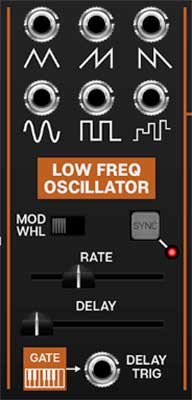
Low Frequency Oscillator
A low frequency oscillator or "LFO," is similar to an audio oscillator, but it typically runs at frequencies below the range of human hearing, and it isn't used an audio source. Instead, its cycling waveforms are used as a control source to add modulation to oscillators, filters, and amplifiers.
A typical application would be to slightly modulate an oscillator’s frequency to create vibrato (pitch modulation), or to modulate a VCA’s amplitude to create a tremolo effect (amplitude modulation). Modulating the cutoff frequency of a filter can create a dubstep-style wobble, or if modulated very slowly, long sweeping tonal shifts.
Unlike the original ARP 2600, we've added an "extra" low frequency oscillator (LFO) - on the original, it was necessary to use one of the voltage controlled oscillators for modulation. The extra LFO leaves all three oscillators available for audio (or extended mod purposes).
Waveform output jacks- Available waveforms include triangle, ramp, sawtooth, sine, square, and random.
Mod Wheel switch and LED- Sliding this to the right normals incoming MIDI mod wheel data to control overall LFO depth; the LED to the right will light. This simplifies setting up CA-2600 for vibrato, pulse-width mod, or filter wah wah with a mod wheel - turn the switch on, patch a cable from the LFO Out to one or multiple oscillator FM mod jacks, and push up the corresponding FM slider.
Important Note: If the Mod Wheel switch is on and your controller's mod wheel is at zero, the LFO won't have any signal output, so... if the LFO doesn't seem to be working, make sure the Mod Wheel switch is in the off position (or push up your controller's mod wheel).
Sync- Engaging the Sync button locks the LFO master tempo. When engaged, the Rate slider snaps to note values ranging from 1/64th note triplet to 8 beats. Sync mode locks to the tempo in the top toolbar when using the CA2600 standalone version or the current project tempo when the plug-in version is used in a DAW.
Rate- Sets the rate of the LFO from 0.01 Hz-20 Hz.
Delay- Moving this slider up gradually delays the onset of LFO depth - think of it like an attack control for LFO depth. By default, the delay is triggered by the keyboard gate (i.e. playing MIDI notes), but can be overridden by plugging a cable into the adjacent jack (try this with a slow clock, for example). The delay range is 0 to 3000 ms.
Note about the Mod Wheel switch and LFO Delay: If the Mod Wheel switch is in the on position (LED lit), the Delay slider grays out and is disabled (because you wouldn’t want the onset of LFO mod delayed when controlling mod amount with a mod wheel).